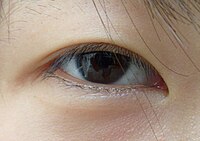
Photo from wikipedia
Importance Understanding the factors associated with nasolacrimal duct probing failure in young children may help inform practice patterns. Objective To identify factors associated with repeated nasolacrimal duct probing in young… Click to show full abstract
Importance Understanding the factors associated with nasolacrimal duct probing failure in young children may help inform practice patterns. Objective To identify factors associated with repeated nasolacrimal duct probing in young children. Design, Setting, and Participants This retrospective cohort study analyzed data from the Intelligent Research in Sight (IRIS) Registry for all children who underwent nasolacrimal duct probing before 4 years of age between January 1, 2013, and December 31, 2020. Main Outcomes and Measures The Kaplan-Meier estimator was used to assess the cumulative incidence of a repeated procedure within 2 years of the initial procedure. Hazard ratios (HRs) derived from multivariable Cox proportional hazards regression models were used to evaluate the association between repeated probing and patient age, sex, race and ethnicity, geographic region, operative side, laterality of obstruction, type of initial procedure, and surgeon volume. Results This study included 19 357 children (9823 [50.7%] male; mean [SD] age, 1.40 [0.74] years) undergoing nasolacrimal duct probing. The cumulative incidence of repeated nasolacrimal duct probing was 7.2% (95% CI, 6.8%-7.5%) within 2 years of the initial procedure. Among 1333 repeated procedures, the second procedure involved silicone intubation in 669 (50.2%) and balloon catheter dilation in 256 (19.2%). Among 12 008 children aged 1 year or younger, office-based simple probing was associated with a slightly higher probability of reoperation compared with facility-based simple probing (9.5% [95% CI, 8.2%-10.8%] vs 7.1% [95% CI, 6.5%-7.7%]; P < .001). In the multivariable model, a greater risk of repeated probing was associated with bilateral obstruction (HR, 1.48; 95% CI, 1.32-1.65; P < .001) and office-based simple probing (HR, 1.33; 95% CI, 1.13-1.55; P < .001), and a lower risk was associated with primary balloon catheter dilation (HR, 0.69; 95% CI, 0.56-0.85; P < .001) and procedures performed by high-volume surgeons (HR, 0.84; 95% CI, 0.73-0.97; P = .02). Age, sex, race and ethnicity, geographic region, and operative side were not associated with reoperation risk in the multivariable model. Conclusions and Relevance In this cohort study, most children in the IRIS Registry undergoing nasolacrimal duct probing before 4 years of age did not require any additional intervention. Factors associated with lower risk of reoperation include surgeon experience, probing performed under anesthesia, and primary balloon catheter dilation.
Journal Title: JAMA ophthalmology
Year Published: 2023
Link to full text (if available)
Share on Social Media: Sign Up to like & get
recommendations!